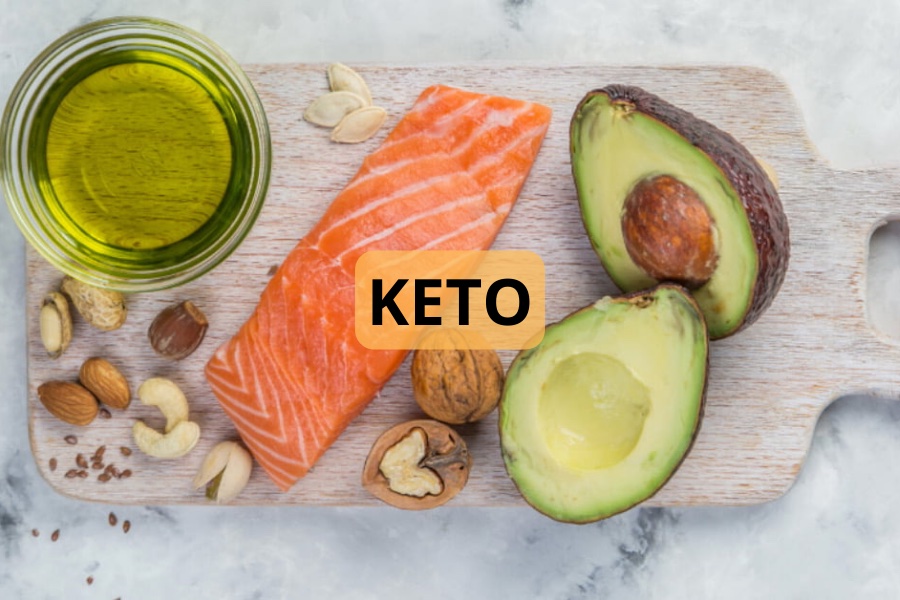No products in the cart.
Return To ShopWhat is Keto diet LCHF (Low Carb, High Fat)or ketogenic diet?
✅What is Keto Diet?
✅What is ketogenic LCHF Low Carb, High Fat diet?
✅What is a ketogenic diet or keto diet?
✅What are the different types of ketogenic diets?
✅What is Ketosis?
✅Is the Ketogenic Diet suitable for people with diabetes and pre-diabetes?
✅What are other health benefits of the Keto or ketogenic diet?
✅What are Keto Diet Foods You Can Eat?
✅What foods to avoid on the keto diet?
✅What is the difference between ketosis and ketoacidosis?
✅ What is a reasonable amount of carbohydrates to eat on a Keto diet?
✅How do you measure ketosis?
✅What is Keto vs LCHF (Low carb, high fat)
✅What is optimal ketosis for the keto diet?
✅What is KETOACIDOSE?
✅Two stages of adaptation to ketosis.
✅How long can you be in ketosis?
✅What is the goal of the keto diet?
✅Why YOU should Use Golden Stevia sugar substitute?
You can find answers to these and other questions in this article!
✅SAMPLE KETO DIET MENU Golden Stevia – Keto Diet Plan
✅How to eat keto food in a restaurant? Tips for eating out
✅What are the side effects of the Keto diet and how can they be minimized?
✅How long does it take to achieve ketosis with the keto diet?
✅“The Keto Diet is a Lifelong Lifestyle”
✅How to use Golden Stevia sugar substitute?
What is Keto Diet?
The Keto (or ketogenic) diet is a low-carb, high-fat diet with many health benefits.
The Keto diet has also become increasingly popular in recent years.
NB! The word “diet” should be read as “low-carb lifestyle with good nutrition” .
Ketogenic diet = low-carb lifestyle
Do you want to eat real food (as much as you want) and improve your health and weight? Then the Keto diet is just for you!
It may sound too good to be true, but LCHF (Low Carb, High Fat) is a method that has been used for 150 years.
The keto diet is beneficial for weight loss, health, and mental and physical performance. The keto diet has been tested for a long time and the Ketogenic diet has even been proven to be beneficial for diabetes, cancer, epilepsy and Alzheimer’s disease.
This article is a detailed guide to the ketogenic diet for beginners. It contains everything you need to know.
What is Keto or Ketogenic diet?
Keto or ketogenic diet involves consuming a very low amount of carbohydrates and replacing them with fat to help your body burn fat for energy.
Health benefits can include weight loss and lowering your risk for certain diseases.
What is ketogenic diet or keto diet?
The ketogenic diet (often referred to as Keto) is a very low-carb, high-fat diet that has many similarities to the Atkins and low-carb diets. This means drastically reducing carbohydrates and replacing them with fat.
Cutting carbs puts your body into a state called ketosis. When this happens, your body begins to burn fat incredibly efficiently for energy.
It also converts fat in the liver into ketones, which can fuel your brain. A ketogenic diet can significantly lower blood sugar and insulin levels.
This, along with increased ketones, has a host of health benefits.
A ketogenic diet (Keto) is a low-carbohydrate, high-fat diet. It lowers blood sugar and insulin levels and switches the body’s metabolism from carbohydrates to fats and ketones.
What are the different types of ketogenic diets?
There are different ketogenic diets such as:
Standard Ketogenic Diet (SKD): This is a very low-carb, high-fat diet. It usually contains 75% fat, 20% protein and 5% carbohydrates.
Cyclic Ketogenic Diet (CKD): This diet involves so-called carbohydrate loading, for example 5 ketogenic diet days and 2 high-carb days.
Planned Ketogenic Diet (TPD): This diet allows you to add carbohydrates to your diet while you exercise.
High Protein Ketogenic Diet: This is similar to the standard ketogenic diet, but with more protein. The ratio is usually 60% fat, 35% protein and 5% carbohydrates.
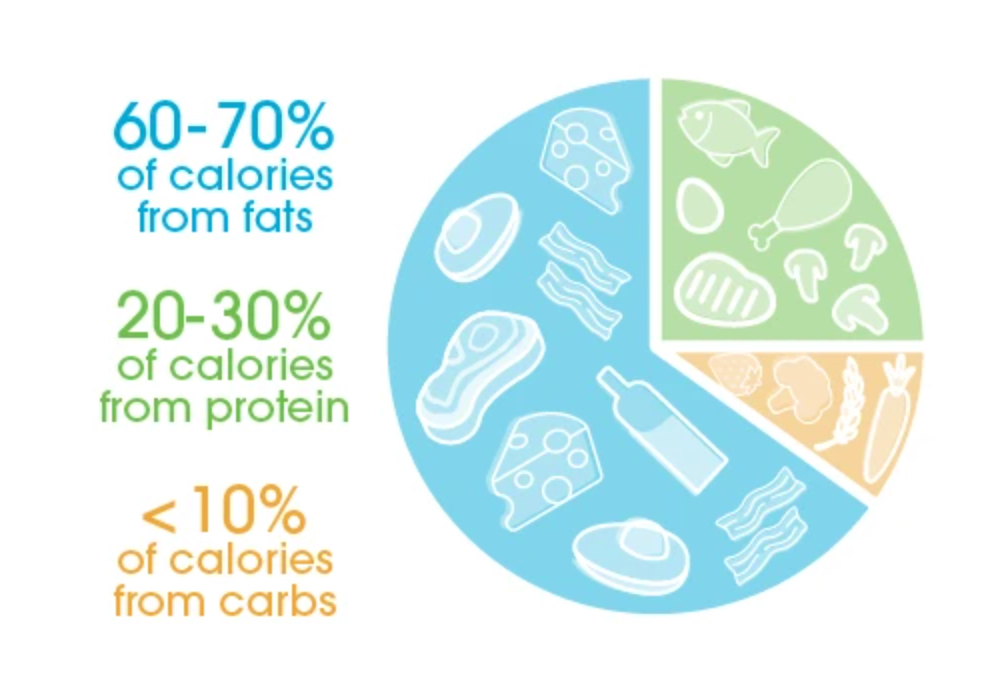
How much carbohydrates should you eat on a Keto diet?
How much exactly is this 5% carbohydrates, 75% fat and 20% protein in grams, I found the answer to be 25g carbohydrates, 189g fat and 86g protein.
NB! You can determine your protein gram as follows: Protein grams are as much as your ideal weight is, for example, 60, then you eat 60g of protein and 2x more fat per day, i.e. 120 grams. Carbohydrate still remains at 25g, in some cases it is also limited to 20g.
However, only standard and high-protein ketogenic diets have been widely studied. Cyclic and planned ketogenic diets are more advanced methods and are primarily used by bodybuilders and athletes. This article focuses primarily on the Standard Ketogenic Diet (SKD), although many of its principles apply to other versions as well.
NB! Remember: There are several versions of the ketogenic diet. The standard ketogenic diet (SKD) is the most researched and recommended.
What is Ketosis?
The Keto or ketogenic diet is named after ketones. This diet causes the body to produce ketones, which are used as fuel in the body for all kinds of activities. The reduction in carbohydrates puts the body into a metabolic state called ketosis.
✅A ketogenic diet can help you lose weight.
✅The keto diet is an effective way to lose weight and reduce the risk of disease.
In fact, studies show that the keto diet is significantly better than the recommended low-fat diet.
And what’s more important, this diet makes you feel so full that you can lose weight without counting kilocalories and watching food portions.
✅One study found that people on a keto diet lost 2.2 times more weight than those on a calorie-restricted, low-fat diet.
Triglyceride and HDL cholesterol levels also improved.
✅Another study found that participants on a ketogenic diet lost 3 times more weight than those on a diet recommended by Diabetes UK.
There are a number of reasons why a ketogenic diet is better than a low-fat diet. One is a higher intake of protein, which brings a host of health benefits.
✅Increased ketones, lower blood sugar, and improved insulin sensitivity may also play a key role.
✅If you want to know more about the weight-reducing effects of the ketogenic diet, read this article: A Ketogenic Diet to Lose Weight and Fight Disease.
NB! Remember: A ketogenic diet can help you lose weight much more than a low-fat diet. This often happens without feeling hungry.
Ketosis is the body’s natural state when eating according to the principles of Low carb, High Fat (LCHF). Keto In the case of a low-carb, high-fat diet, the intake of carbohydrates is restricted, the body has to reprogram itself from the main source of energy in the form of carbohydrates (glucose) to using fat as energy. This is called ketosis.
What is Ketosis?
Ketosis is a metabolic state in which your body uses fat for fuel instead of carbs. Modifying your diet and practising intermittent fasting can help you enter ketosis faster. Specific tests and symptoms can also help determine whether you’ve entered ketosis.
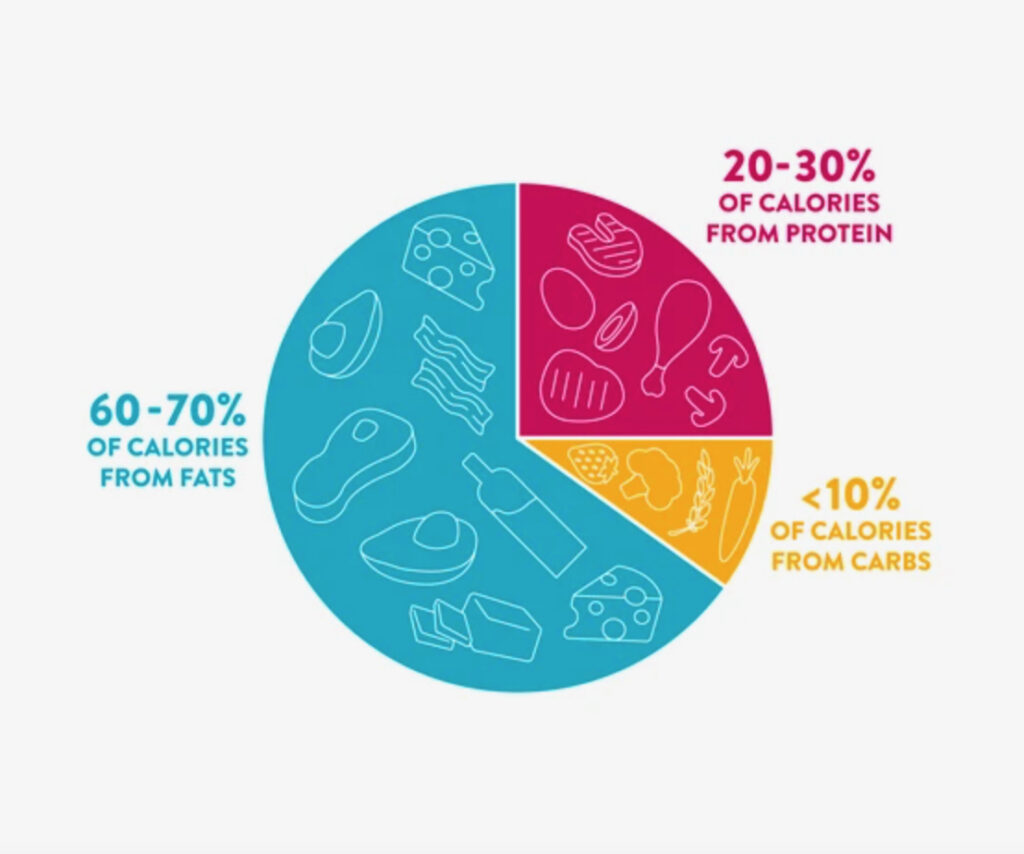
Is the Ketogenic Diet suitable for people with diabetes and pre-diabetes?
Diabetes is characterized by changes in metabolism, high blood sugar and impaired insulin function.
A keto diet can help you lose excess fat, which is closely associated with type 2 diabetes, pre-diabetes, and metabolic syndrome.
One study found that a ketogenic diet dramatically improved insulin sensitivity by 75%.
Another study of people with type 2 diabetes found that 7 out of 21 participants were able to stop taking all diabetes medications.
And another study where the keto group lost 11.1 kg of body weight compared to 6.9 kg for the group on a higher carb diet. This is an important benefit given the link between weight and type 2 diabetes.
In addition, 95.2% of the ketogenic group were able to reduce their diabetes medications compared to 62% of the high-carb group.
NB! Remember: A ketogenic diet can improve insulin sensitivity and cause fat burning, leading to drastic improvements in type 2 diabetes and pre-diabetes.
NB! Type 1 diabetics must also add insulin during the keto diet, because the body produces carbohydrates from fat and these are also carbohydrates and raise blood sugar.
What are the other health benefits of the Keto or ketogenic diet?
The ketogenic diet has actually originally been used to treat neurological diseases such as epilepsy. Research has shown that this diet can help with many more different health conditions:
✅Heart disease: A ketogenic diet can reduce risk factors such as obesity and improve HDL levels, blood pressure and blood sugar.
✅Cancer: This diet is used in the treatment of various cancers and tumors.
✅Alzheimer’s disease: This diet can reduce the symptoms of Alzheimer’s disease and slow the progression of the disease.
✅Epilepsy: Studies have shown that a ketogenic diet significantly reduces seizures in children with epilepsy.
✅Parkinson’s disease: One study found that this diet reduces symptoms of Parkinson’s disease.
✅Polycystic ovary syndrome: A ketogenic diet helps lower insulin levels, which can play a key role in polycystic ovary syndrome.
✅Acne: Lower insulin levels and cutting down on sugar and processed foods can help reduce acne.
However, note that research in several of the aforementioned areas is far from being the final truth.
NB! Remember: A ketogenic diet can provide numerous health benefits, especially for metabolic, neurological and insulin-dependent diseases.
Note for diabetics
By avoiding carbohydrates that raise blood sugar, you reduce the need for medications that lower blood sugar. If you take the same dose of insulin as before, hypoglycemia (low blood sugar) may occur. In the beginning, you have to constantly check your blood sugar levels and adjust (reduce) the medication doses. This should ideally be done with the help of a doctor. If you are healthy or a diabetic who is treated only with diet or only with metformin, then there is no need to fear the development of hypoglycemia.
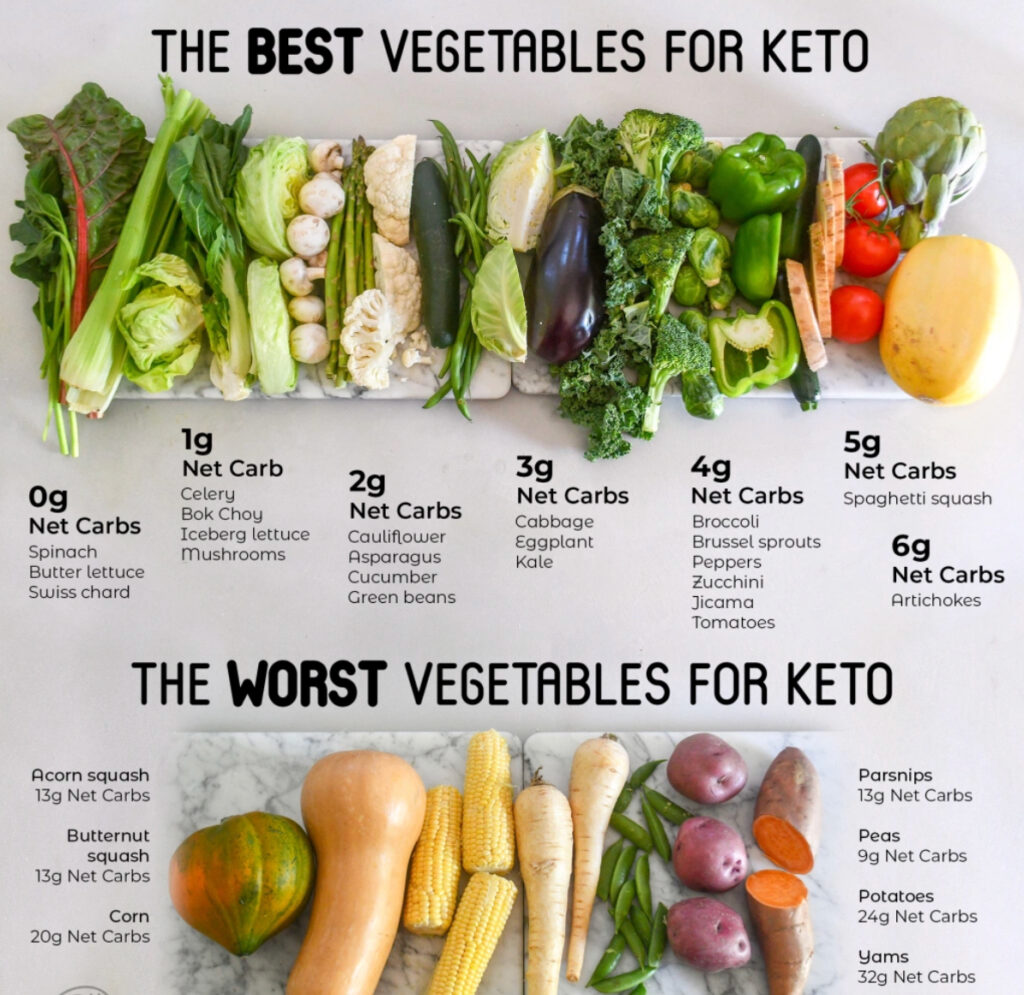
What are the Keto Diet Foods You Can Eat?
On a keto diet, the main part of your diet should be covered with such foods:
Meat: Red meat, steak, ham, sausages, bacon, chicken and turkey.
Fatty fish: Salmon, cod, tuna, mackerel.
Eggs: Look for free-range or omega-3 eggs.
Butter and cream: Look for mild if possible.
Cheese: Unprocessed cheese (cheddar, goat cheese, cream, blue cheese or mozzarella).
Nuts and seeds: Almonds, walnuts, flax seeds, pumpkin seeds, chia seeds, etc.
Healthy oils: Mainly extra virgin olive oil, coconut oil/fat and avocado oil.
Avocados: Whole avocados or freshly made guacamole.
Low-carb vegetables: Most green vegetables, tomatoes, onions, peppers, etc. (all vegetables that grow on the ground are ok)
NB! Remember: Base your menu around foods like meat, fish, eggs, butter, nuts, healthy oils, avocados and plenty of vegetables.
What foods to avoid on the keto diet?
In short, all foods high in carbohydrates should be avoided. Here is a list of foods you should cut back on while on the ketogenic diet
completely avoid:
Foods rich in sugar: Lemonades, fruit juices, smoothies, cakes, ice cream, candies, etc.
Cereals and starch: Wheat flour products, rice, pasta, flakes, etc. (any cereal, including buckwheat)
Fruits: Any fruit, excluding berries such as strawberries.
Beans and lentils: Peas, beans, lentils, chickpeas, etc.
Roots and tubers: Potatoes, sweet potatoes, carrots, parsnips, etc.
Low-fat dairy products: These are highly processed and high in carbohydrates.
Unhealthy fats: Reduce consumption of processed vegetable oils and mayonnaise.
Alcohol: Because of their carbohydrate content, alcoholic beverages can throw you out of ketosis.
Sugar-free diet foods: These are often high in sugar alcohols, which can affect ketone levels in some cases. These foods are often excessively processed (from sugar alcohols, only pure erythritol and Stevia may be suitable for some people)
SUGAR is also honey, agave syrup, palm sugar, all of which you eat in the same amount as sugar and which contain a lot of carbohydrates
NB! Remember: Avoid carbohydrates such as grains, sugars, lentils, rice, potatoes, candies, juices and fruits.
Lorem ipsum dolor sit amet, consectetur adipiscing elit. Ut elit tellus, luctus nec ullamcorper mattis, pulvinar dapibus leo.
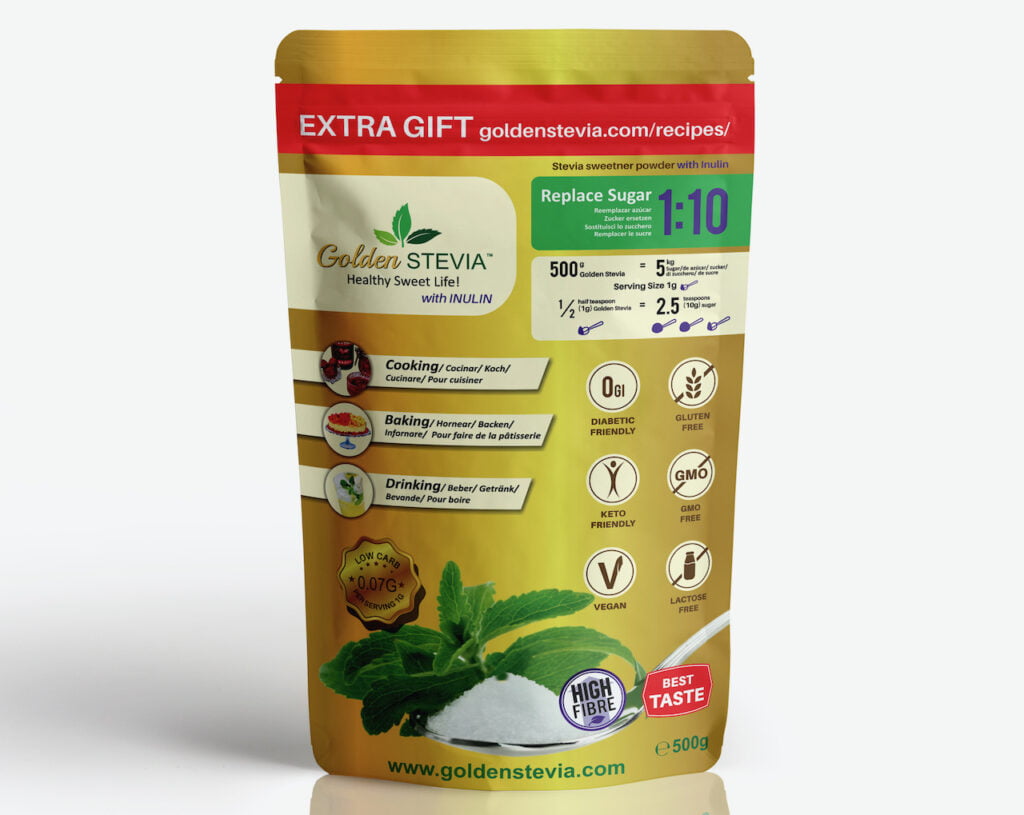
GOLDEN STEVIA is perfect for a Keto diet, as you use 1 gram (1/2 teaspoon) per serving and does not increase blood sugar, insulin consumption or take you out of ketosis.
What is the most affordable, tasty and best sugar substitute is Golden Stevia?
You can buy Golden Stevia Sweetener 1:12 here:
READ ALSO:
Why is Golden Stevia Better than sugars or other Sugar Substitutes?
Golden Stevia sugar substitute is the most affordable, tastiest and best!
How?
What consumers, diabetics think about Golden Stevia Products!
Golden Stevia is a flavoring, you use it like chili or cinnamon with just a pinch!
Golden Stevia articles, news:
Come Join our newsletter, you will get a -10% discount code for the purchase of Golden stevia sugar substitute.
Our newest product Golden Stevia Sugar Substitute 1:10 with Inulin is the best thing that can happen to you! Since our Golden Stevia 1:12 sugar substitute is very scandalous and causes various aromas, then Golden Stevia 1:10 Prebiotic with inulin, fiber and it is not even possible to drag it into scandal anymore.
Here you can read What do consumers, including diabetics, think about the Golden Stevia product?
You can buy Golden Stevia sugar substitute with Inulin 1:10 here:
Here you can read What do consumers, including diabetics, think about the Goldena Stevia product?

What is a reasonable amount of carbohydrates to eat on a Keto diet?
In order for the body to enter the state of ketosis, it is necessary to limit the daily consumption of carbohydrates to 20-40 grams. In this case, the body does not get enough glucose to keep those organs that need glucose to function (such as the brain) working. Ketosis means that the liver produces ketones from fat, and when the body has reprogrammed itself, the ketone bodies act as a substitute for glucose. During the reprogramming of the body, there may be various transitional ailments. Ketosis is a state of the body that results in extremely high fat burning. Even the brain then runs on fat fuel, through ketones. Ketones are energy molecules in the blood (like blood sugar) that are produced in the liver from fat and become fuel for the brain.
In order for the production of ketones in the body to start, the level of the hormone insulin in the blood must be low. The lower the insulin, the stronger the ketosis. If you are in ketosis, you will get the maximum effect from your low-carb diet.
How do you measure ketosis?
Ketosis can be measured in blood and urine. For example, we measure 2 in one with the CareSens Dual glucometer. It can be used to measure both the blood sugar level and the level of β-ketones in capillary blood. KetoSens blood β-ketone test strips are required for measurement. They are in separate blood glucose test strips.
NB! In the case of type 1 diabetes, the whole topic of Ketosis is the responsibility of the diabetic. Doctors certainly do not take any responsibility and in any case say that you should not follow a ketogenic diet.
Ketones, or ketone bodies, are created when fatty acids are broken down into energy. If there are too many ketone bodies in the blood, it can be a sign that the diabetes is getting out of control and this is where ketoacidosis develops, only in diabetes #1, not in a healthy person.
What are the most common mistakes people make when following Keto diet principles?
Why can’t you reach to ketosis?
Many people believe that they follow the keto diet and know what it is, strictly keep and follow to the principles of Low Carb, High Fat LCHF, but are surprised when they measure their ketones in the blood (using a blood sugar meter or keto stix). Because not in optimal ketosis. In this case, if you have been following a strict Keto Low Carb High Fat (LCHF) diet but still haven’t reached optimal ketosis, it not only helps to avoid the obvious bigger sources of carbohydrates (such as candy, bread, pasta, rice, potatoes), but it is also worth being careful with the amount of protein. If you eat very large amounts of meat, eggs, etc., the excess protein is converted into glucose. Even a larger amount of protein can raise your insulin a little. In this case, you will never reach optimal ketosis.
It’s also important to moderate your protein consumption. This is because protein can be converted into glucose if consumed in high amounts, which may slow your transition into ketosis (10Trusted Source).
Practising intermittent fasting could also help you enter ketosis faster. There are many different forms of intermittent fasting, but the most common method involves limiting food intake to around 8 hours per day and fasting for the remaining 16 hours (11Trusted Source).
Keto diet everyday tips!
Keto Magic Bullet Coffee
Many also use the trick of drinking fatty coffee (Magic Bullet Coffee or MBC) to fill their belly with fat.
A large tablespoon of butter and the same amount of coconut fat go into the coffee, which is beaten using a hand mixer or blender.
Use more coconut fat/ olive oil fat/ animal fat/bacon!
Eating more fat will make your stomach feel fuller. Therefore, you eat less protein and even fewer carbohydrates. Your insulin drops to the bottom and you manage to reach optimal ketosis.
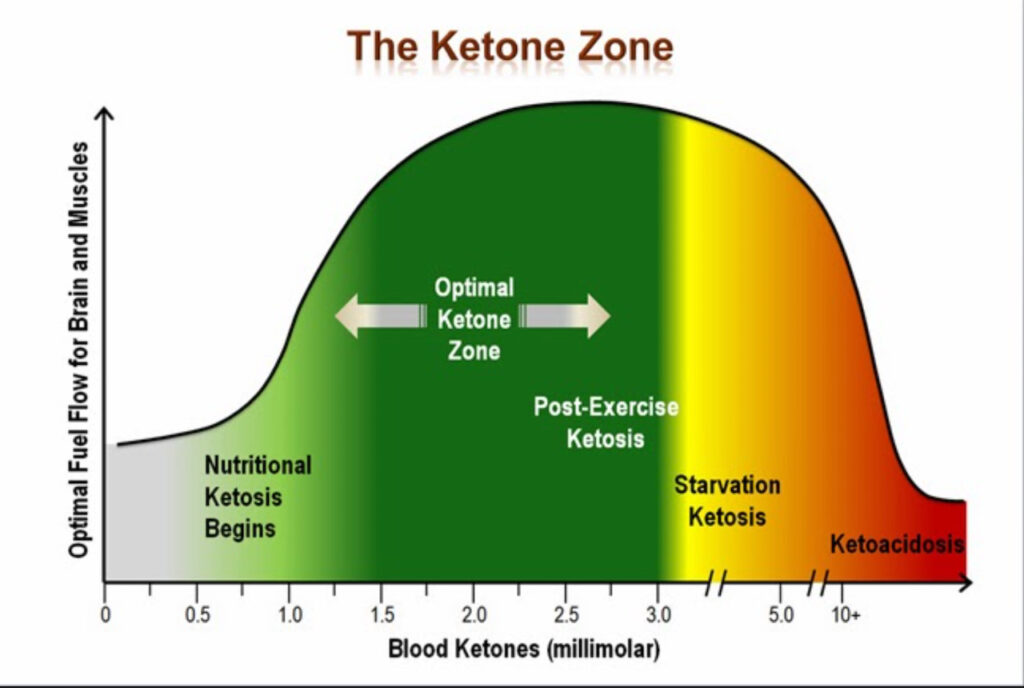
What Is Optimal Ketosis For The Keto Diet?
- Starvation ketosis: 3-5 mmol/L ketones in the blood. If you don’t eat anything, the value of ketones rises to almost 5 mmol/L, that is, if you simply do not eat enough calories. This condition occurs with a whole range of soup, syrup and powder diets.
- Dietary ketosis of 1.5-3 mmol/l occurs with low carbohydrate and moderate protein consumption, with the amount of energy available remaining the same.
It’s easy to confuse the two conditions ketosis and ketoacidosis, he media often do when they say that ketosis is dangerous. Namely, dietary ketosis and starvation ketosis affect the body’s metabolism very differently.
Starvation ketosis leads to a slowdown in metabolism. In the case of dietary ketosis, the slowing down of the metabolism can be avoided or even accelerated.
In fact, ketosis is a normal state of the body, but in modern man it only occurs when he consciously avoids the large amount of carbohydrates that surround him. Everyone could strive for ketosis.
What Is Ketoacidosis ?
Ketoacidosis is a medical condition in untreated type 1 diabetics, advanced type 2 diabetics, or someone with a long-term alcohol problem. In such groups, the number of ketones is 5-10 times higher than in a healthy person. It is a life-threatening condition.Ketoacidosis
Two Stages Of Adaptation To Ketosis
- In the early days of the ketogenic diet, your body still runs on glycogen stores. This is the most challenging part of the process because in order to get out of the vicious cycle of glucose-based metabolism, you have to avoid eating carbohydrates, even though your glycogen stores are depleted. Fat-based metabolism is not yet optimized and ketone production is not yet sufficient, which is normal on a keto diet.
- Another observation in the first few days is water loss. One of the inefficiencies of glycogen stores is that they must be stored with water. About 3-4 grams of water are needed to store one gram of glycogen. This means that along with depleting your glycogen stores, you can lose up to 2 kilos of water! And not only that – because high insulin levels cause water retention, which prevents the excretion of salt.
How to make the transition to ketosis painless as possible?
As already mentioned above, it is the first part of adapting to ketosis that is difficult. There are two reasons for this. The first reason is that glucose remains less and less in the body, but ketone metabolism has not yet started to work effectively. The best strategy to deal with this is to eat a lot of fat.
Although you ultimately want your body to draw most of its fat from your own fat stores, you don’t need to limit the fat you eat, especially not now. Fat is an essential source of fatty acids and nutrients. In addition, fat eaten with protein helps to balance the insulin response. The ketogenic diet is not a high-protein diet, it is a high-fat diet. Don’t be afraid of it. Eat plenty of fat while adapting to ketosis, which will ensure you have sufficient energy reserves.
Keto and Salt
Another problem is the salt mentioned above, excretion and fluid loss. You need to replenish your salt and water reserves to avoid losing salt and potassium too quickly. It can cause fatigue, weakness and headaches.
Ensure you get enough salt: around 5 grams or 2 teaspoons of table salt daily will help prevent these symptoms.
An adequate amount of potassium is necessary to maintain muscle mass, and magnesium deficiency can cause muscle cramps, fatigue, and drowsiness. Both of these minerals are present in the meat, but they are easily lost during cooking – into the boiling water of the meat bones (broth) or into other liquid coming out of the meat. In addition to using the liquid secreted from the meat, taking magnesium and potassium as a food supplement can also be beneficial. We recommend drinking meat broth regularly.
Ultimately, we recommend keeping your carb intake low. The worst-case scenario is to eat a small number of carbohydrates every few days – that way you’ll bring yourself back to the beginning in the adaptation phase and you’ll be in a constant state of hell. It is not a good time to test your carb tolerance or eat foods you don’t know the ingredients for. Stick to very low carbs consistently, at least until you get your ketone production fully up and running. For most people, any discomfort will disappear in 4-5 days. However, the metabolic changes will continue for at least another two weeks or even more. We recommend going with almost zero carbs for 30 days to allow you to experience a full ketogenic state.
Ketobodies and glucose are competing fuels
You cannot reach a state of zero blood sugar – for example, there are brain cells that can only function on glucose, even though the amount of glucose that the brain needs is minimal and does not have to come from food. The brain can use multiple fuel sources, and the brain becomes more efficient by doing so. A brain that only runs on glucose is not efficient. The problem is that the Standard American Diet (SAD) teaches the brain to run solely on glucose fuel – to such an extent that the brain becomes dependent on glucose and begins to minimally uses other available fuels. Such a situation leads to premature ageing, neurodegenerative diseases and reduced gray matter in the brain. It also affects genes that lead to cancer, CVD and autoimmune diseases.
What is the Keto diet goal?
Our goal is to make our glucose-dependent brains run on several other alternative fuels, the way our brains were originally designed to run. Astrocytes, for example, produce their own ketone bodies in the brain because the brain wants to use ketone bodies, despite the fact that we have suppressed the brain’s desire to do so with our constant overdose of glucose. All we need to do is supply the brain with enough ketone bodies to allow it to function optimally.
A sign of adaptation to ketosis is a regular fasting blood sugar below 4.7 and morning ketone bodies between 0.5-3.
But how do we do it?
Well, first, they started testing keto bodies. If my body already produces ketones, I’m using them, right? Well. Now let’s pick up some momentum. We do know that a large number of ketone bodies circulating in the blood and even pure fatty acids can reach the mitochondria of muscle tissue through the capillaries and supply them with energy. Ketobodies can reach the brain only if the circulating blood glucose level is low. Only when we understand HOW ketone bodies get to the brain do we realize that blood glucose levels are not only relevant but extremely important.
.
Healthy keto snacks
In case you get hungry between meals, here are some healthy, keto-approved snacks:
✅Fatty meat
✅Cheese
✅Ham
✅Nuts and seeds
✅Olives
✅1-2 eggs
✅Dark chocolate with at least 90% cocoa content
✅Fatty plain yoghurt with Golden Stevia Sweetener 1:10 and cocoa powder 99% low carb
✅Strawberries
✅Celery
✅A small amount of leftover food from a previous meal
Easy keto diet delicious snacks are meat, cheese, olives, eggs, nuts, raw veggies and dark chocolate.
Tips for eating out with ketogenic diet and keto food in a restaurants
It’s not very difficult to make most restaurant meals keto-friendly. Most restaurants offer meat and fish dishes. Order them, replace any carbohydrate-rich part with vegetables, and ask for a vegetable or salad instead of potato-rice-buckwheat.
Egg dishes, such as an omelette or a fried egg with bacon, are also a great option. Another favourite is the bunless burger, often served with lettuce leaves. You can always ask for vegetables instead of bread and fries. Add extra avocado, cheese, bacon or egg.
NB! Remember: Choose meat, fish, and egg dishes when eating out. Order extra vegetables instead of carbohydrate- and starch-rich foods, and have cheese for dessert.
What are the side effects of the Keto diet, and how can they be minimized?
Although the ketogenic diet is healthy, switching to it can have side effects that can last for a few days. Side effects may include decreased energy levels and mental function, increased appetite, sleep disturbances, nausea, indigestion, and decreased physical performance. Try a regular low-carb diet for a few weeks before going on a ketogenic diet to reduce these symptoms. This teaches your body to burn fat before giving up most of the carbs.
A ketogenic diet can also change your body’s water and mineral balance, so adding extra salt or supplements can help. Try taking 3,000-4,000 mg of sodium, 1,000 mg of potassium, and 300 mg of magnesium daily to reduce side effects.
At least in the beginning, it is essential to eat full and avoid any excessive restriction of kilocalories. Typically, a ketogenic diet provides weight loss without calorie restriction.
How long does it take to reach and adapt to ketosis on a keto diet?
If you eat ketogenic, low carb, high-fat food, the body goes into ketosis, which means that the body burns fat so fast that ketones are produced as a waste product. Ketones can be found in urine, blood and exhaled air. The body can burn glucose (sugar), free fatty acids, ketones and alcohol. The body first uses the fuel it has the most. When you eat sugar, your body burns sugar. When you drink alcohol, your body burns alcohol.
One of the goals of ketosis is to adapt to ketosis, and many keto enthusiasts struggle with this for a very long time. Namely, being in ketosis and fully adapting to ketosis is not the same thing. If you have adapted to ketosis, the need for carbohydrates disappears completely, you do not need any performance-enhancing carbohydrates for exercise, and the body is healed from the inside. No inflammation, adrenal fatigue, leaky gut syndrome, or anything like that.
Very few people are completely keto-adapted! Most people on a low-carb diet are not. They may burn fat and function better on a low-carb diet, but they still need and crave carbs and junk food. Their bodies are still inflamed, they continue to have stressed adrenal glands and they have mental and physical problems such as fatigue, pain, signs of ageing, etc. But it doesn’t have to be that way!
Adapting to ketosis takes time. Give yourself time. Even after 5 years of LCHF eating, you are not in ketosis all the time. As the year goes on, you will achieve ketosis for longer periods and it will be easier and easier to fast. The more you are, the more energetic you are, the better you sleep, and the better your body is, slowly but surely. If a person has more health problems at the start, it takes more time and along the way you get to know yourself and your body better and better.
To get to ketosis it typically takes 2–5 days to enter ketosis if you eat fewer than 50 grams of carbs per day. However, some people may take longer depending on factors like physical activity level, age, metabolism, and carb, fat, and protein intake.
“The Keto Diet is a Lifelong Lifestyle”
The first step in adapting to ketosis is expressed in increased performance, and to get there, your whole insides don’t have to be improved yet. It’s enough if you’ve been in ketosis for a few months, and it doesn’t have to be in one go. You can already feel the signs of improvement if you have only been in ketosis occasionally. It is how you slowly train your body’s ability to use ketones as an energy source.
Tags: Keto diet
About author
Related posts
What is Monkfruit sweetener, sugar substitute? Continue reading
How to use Golden Stevia sweetener in your coffee and food? You only use it 0.5... Continue reading

